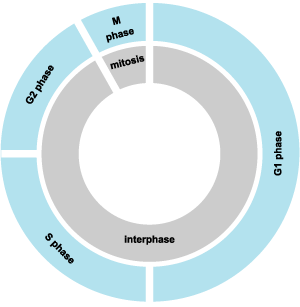Eukaryotic Cellular Division Process
Every cellular organism uses the process of Cellular Division. This is where genetically identical daughter cells are produced from parent cells. The daughter cells must be able to carry out the same functions as the parent cell.
The Cell Cycle is the series of events in which a parent cell divides to produce identical daughter cells which then grow to full size. This may in fact be the whole Life Cycle of the organism, if it is a single-celled organism.
- Cellular Division occurs for:
- Asexual Reproduction: Single-celled, and sometimes multicellular organisms (through budding) reproduce by dividing.
- Growth: Cells are produced so that multicellular organisms can grow.
- Replacement: Any cells in multicellular organisms that have been worn out or have been damaged need to be replaced by cellular division.
Eukaryotic Cell Cycle
- In Eukaryotes, the cell cycle is divided in Interphase, where the cell readies itself for division, and Mitosis, where the process of division occurs. Interphase takes up the majority of the cell cycle. Meiosis can sometimes occur instead of Mitosis.

Interphase
- Interphase can be divided into 3 discrete stages:
- G1: Gap Stage 1
- S: Synthesis Stage
- G2: Gap Stage 2
- During Gap 1, the cell functions normally and protein and organelle synthesis occurs such that the cell doubles in size. The extra proteins and organelles mean that both daughter cells will be able to function the same as their parent cell.
In the Synthesis Stage, DNA is replicated. This is done by Semi-conservative Replication, and produces two identical copies of each Chromosome.
Chromosomes are wrapped around proteins called Histones in Eukaryotes, and together with these proteins, Chromosomes are called Chromatin. After DNA replication has occurred, two identical Chromosomes, called Sister Chromatids are formed held together at a point termed the Centromere.
When DNA replication happens, it is checked for any incorrect copying which may result in mutations that stop the new cell working.
During Gap 2, more growth occurs and proteins are rapidly synthesised in preparation for Mitosis.
Mitosis
The process of Mitosis can be described as happens in 4 phases: Prophase, Metaphase, Anaphase and Telophase. Most animal cells are capable of Mitosis, whereas only Meristematic cells in plants are capable of Mitosis.
The first phase, Prophase, involves the Supercoiling of the Chromosomes. They shorten and thicken such that it is now possible to see them using a light microscope.
In animals, an organelle called the Centriole divides in two and begins to form protein threads called Spindle Fibre. In plants, Tubulin Protein Threads are made in the Cytoplasm. This will attach to the Centromeres on the Sister Chromatids. The Nuclear Envelope also disappears.
In Metaphase, the Chromosomes line up towards the centre of the cell, held by the Spindle Fibre.
During Anaphase, the Spindle Fibres contract, which separates the Sister Chromatids so that one goes to each end of the cell. They do this pulled by the Centromere, giving them a ‘V’ shape.
Finally, in Telophase, the Spindle Fibres break down and a Nuclear Envelope forms around the two sets of Sister Chromatids at each end of the cell. The Chromosomes uncoil so that they are no longer visible to a light microscope.
The cell now splits in two in a process called Cytokinesis. In animals cells this starts from the outside, with the membrane ‘nipping in’. However, in plants, a cell plate first forms to slit the cell in two, and cell membrane and wall material is laid out along this plate.
